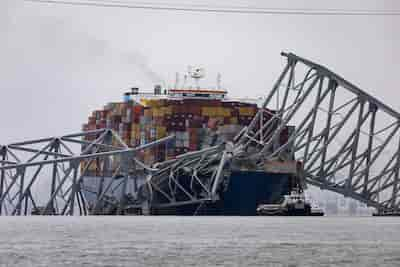Critical Part of Collapsed Baltimore Bridge Destroyed in Controlled Demolition
As workers continue a more than one-month-long effort to free the ship and its onboard crew from a shipping channel used to access the Port of Baltimore, they destroyed a portion of the collapsed Francis Scott Key Bridge in Baltimore that was stuck atop the ship that crashed into the bridge on Monday through controlled demolition.
Six construction workers were killed when the bridge collapsed on March 26. They were patching potholes when the cargo ship struck a support beam. Last Monday, the identity of the sixth and last victim of the collapse was revealed. The collapse of the bridge affected 500 local companies and around 15,000 workers’ jobs. Since the incident, the crew of the ship, known as the Dali, has remained on board and responded to inquiries from FBI and NTSB investigators. The majority of the staff is Indian.
Baltimore, Maryland (AP) – With a boom and a splash, the damaged steel trusses of the collapsed Francis Scott Key Bridge in Baltimore fell into the river below as crews detonated a series of precisely positioned explosives on Monday to destroy the largest surviving span.
When detonated, the explosives released plumes of black smoke and displayed an orange light. A torrent of water splattered back at the stranded Dali container ship as the longest trusses fell away from it and dropped off its bow.

It was a significant step in releasing the Dali, which has been trapped amidst the debris since it lost power and collided with a support column of the bridge soon after departing Baltimore on March 26.
Six construction workers lost their lives in the fall, which also stopped most marine activity through Baltimore’s important port. Refloating the Dali and resuming port traffic are the outcomes of the controlled demolition, which will also help thousands of small business owners, truck drivers, and longshoremen who have lost their employment as a result of the shutdown.
Officials said the detonation went as planned. According to them, evaluating the few trusses that remain on the Dali’s bow and ensuring that no submerged debris is impeding the ship’s ability to be refloated and relocated are the next steps in the dynamic cleanup process.
According to U.S. Army Corps of Engineers Lieutenant General Scott Spellmon, “it’s a lot like peeling back an onion.”
In a few days, officials hope to refloat the ship. It will then be guided to a neighbouring port terminal by three or four tugboats. Before being sent to a shipyard for more extensive maintenance, it will probably stay there for a few weeks and receive interim repairs.

Col. Estee Pinchasin, Baltimore District Commander of the Army Corps of Engineers, declared immediately following the destruction, “This was a very big milestone for our progression forward.” According to her, the personnel don’t plan on using any more explosives.
The crew of the Dali stayed on board the ship during the blast, and according to Capt. David O’Connell, the commander of the Port of Baltimore, no casualties or issues were reported.
Since the accident, the crew members have not been permitted to leave the stranded ship. The ship’s maintenance and the investigators’ assistance have occupied officials’ time, they claimed. Twenty of the crew are Indian, while one is Sri Lankan.
The span, which is said to be 500 feet (152 meters) long and weights up to 600 tons (544 metric tons), was intended to be destroyed using explosives, but engineers had to spend weeks getting ready. Thunderstorms on Sunday forced a postponement of the demolition.
At a press conference on Monday, Governor Wes Moore said, “This is a best practice,” adding that no one has been hurt thus far while the cleaning was being done. “Our first priority in this operation is safety.”
According to authorities, fire personnel were positioned nearby during the explosion in case any flying sparks caused any problems.
Authorities stated last week in a videographic that engineers were controlling the way the trusses broke by making precise cuts. They claimed that the technique is among the safest and most effective techniques to remove steel under high strain and that it permits “surgical precision.” The fractured steel portions will now be lifted onto ships using hydraulic grabbers.
The FBI and the National Transportation Safety Board are looking into the collapse of the bridge. The ship’s electrical system will be the main focus of the safety board probe, according to officials.
The Dali was hired by the massive Danish shipping company Maersk to go from Baltimore to Sri Lanka, but it never made it that far. The crew reported losing power and losing control of the steering system in a mayday call. The ship struck the bridge shortly after.
The salvage teams and other cleanup personnel who assisted in locating the bodies of the six construction workers have received praise from state and federal authorities. Last week, the final corpse was pulled from the submerged wreckage. The victims were all immigrants of Latino descent who travelled to the United States in search of employment. The bridge was demolished when they were working an overnight shift patching pothole.
By the end of May, officials said, the operation is still on schedule to restore the port’s 50-foot (15-meter) deep draft canal. Crews have created a temporary, somewhat shallower channel in the interim. 365 commercial vessels, according to officials, have been through the port in the last several weeks. Typically, the port handles more automobiles and agricultural machinery than any other in the nation.
The Key Bridge catastrophe was linked by former House Speaker Nancy Pelosi, a native of Baltimore whose father and brother were mayors decades before, to the midnight assault of Baltimore’s Fort McHenry, which long ago served as the inspiration for Francis Scott Key’s writing of “The Star-Spangled Banner” during the War of 1812. Both, according to her, demonstrate Maryland’s tenacity.
Along with two of her cousins, Pelosi, a Democrat and representative for California’s 11th district, was present at the press conference on Monday. She applauded the way government agencies came together in the wake of the tragedy and worked swiftly without compromising security.
“Evidence that our flag remained there throughout the night,” she remarked. “That’s the power of Baltimore.
What took place?
All of the small explosive devices that were positioned above the bridge’s span exploded in a matter of seconds.
The steel had been cut where the explosives were positioned, and the cuts were covered with what seemed to be heavy-duty tape.
Those within two thousand yards were advised to wear hearing protection because to the explosive sound, which resembled fireworks.
This procedure was deemed the “safest and swiftest” by the U.S. Army Corps of Engineers for removing the thousands of tons of wreckage that were pinning the enormous ship.
The truss was hurled into the Patapsco River in fragments by the controlled detonation. A process animation was released by the officials.
Over twenty crew members stayed on board during it all.
They are a component of the ship; thus, they will remain on board. They are required to maintain the ship’s operating safety,” U.S. Coast Guard Rear Admiral Shannon Gilreath stated.
The first objective is safety.
The governor of Maryland, Wes Moore, described the risky operation involving several tiny explosions timed precisely to release the tons of steel from the ship and into the Patapsco River.
The weather had caused it to be delayed twice.
“Our first concern in this operation is safety. We arrived at this assignment unscathed,” Moore remarked.
restoring Dali’s flotation
The Dali’s removal is the next phase, according to U.S. Army Corps of Engineers Colonel Estee Pinchasin.
Opening the canal and removing the ship will still take a few days.
Once the wreckage falls into the channel, we will have the vessel refloated,” said Pinch Asin. “Just like we have over the past seven weeks, our salvors are prepared with the necessary equipment to recover the wreckage. They’ll have to either use the grabber to raise it and then remove it after further chopping it down.
Response is shown in body-worn camera video.
The Maryland Department of Natural Resources just released body-worn camera footage that captured the police’s immediate reaction in the dim, debris-filled river following the bridge collapse on March 26.
The emotional reaction is captured on camera when authorities arrive by boat at the scene of the accident. In one video, an officer can be seen talking with the crew as they approach the Dali.
A note for the victims of the bridge collapse
For the families of the six victims who lost their lives today, the governor had a message. The last corpse was found last week.
I promised we would do everything in our power to bring your family members back, and I pray that the fulfilment of our word can bring you some peace,” said Moore.
legal firms to support future litigation
The attorney general of Maryland gathered five legal firms to help with any future litigation.
A proposal for a “contingent fee contract” for a group of legal companies to serve as the assistant attorney general’s counsel in order to bring legal action against the parties accountable for the collapse of the Francis Scott Key Bridge has been authorized by the Maryland Transportation Authority Board.



